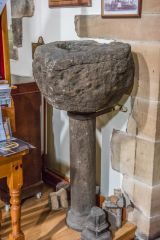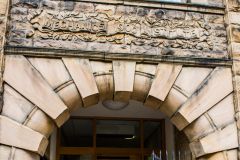
History
The name Haltwhistle comes from the Old English Haltwezell, meaning 'high place', or, alternatively, 'a hilltop with two streams'. The Romans built the Stanegate road, linking Carlisle to Corbridge, a few miles to the north, and Emperor Hadrian built his famous wall along roughly the same course. There seems to have been only limited Roman presence at Haltwhistle, though sherds of pottery have been found.
Haltwhistle was a small settlement by the time St Aidan brought Christianity to the area in the 7th century. One of the early Christian missionaries was St Paulinus, first Bishop of York (d. AD 644), who converted the King of Northumbria to Christianity. The parish church of Holy Cross is an ancient building, which may date to the 9th century, and within it is preserved a 7th-century water stoup thought to have been used by St Paulinus for baptisms.

The town grew as a trading centre in the medieval period, and King John granted it the status of 'market town' in 1207. The town was granted a royal charter to hold a market in 1306 and the market is still held today.
The town's location on a major trading route made it a target for Scottish raiders. In 1598 the Scots sacked and burned the town in a raid known as 'The Fray of Haltwhistle'. Then a pair of powerful reiving families, the Armstrongs and Ridleys, engaged in a bloody feud. Look for the ornately carved grave slab of an earlier Ridley in Holy Cross church.
The townsfolk protected themselves by building peles (fortified towers) and bastle houses, a fortified farmhouse with thick stone walls and space for animals on the ground floor and people above, with no internal stair linking the two levels. The area around Haltwhistle's market place has the largest number of surviving bastles in England, and these are marked by plaques so that visitors can follow a 'bastle trail'.
One of the most prominent historic buildings is the Centre of Britain Hotel, built as a pele tower in the late 15th century.
Haltwhistle was a centre for the wool trade in the 17th century, with local farmers using the clear, cold waters of Haltwhistle Burn to wash the wool. During the Victorian period, the town was transformed into a lead mining centre and its population trebled when the rail line to Alston arrived in the 1850s.
In the market place is a Centre of Britain memorial set into the pavement, near a large Whinstone block commemorating the town's mining heritage.
Haltwhistle prides itself on being 'The Centre of Britain', being equidistant from the sea if you measure along the principal points of the compass. That calculation, however, only works if you use Orkney as the northernmost point of Britain rather than Shetland. Even if the geographical claim is open to debate, the town itself makes a very good centre for exploring Hadrian's Wall country.






 We've 'tagged' this attraction information to help you find related historic attractions and learn more about major time periods mentioned.
We've 'tagged' this attraction information to help you find related historic attractions and learn more about major time periods mentioned.



